
Volume 35 - Spring 2013
High Church
Fan Binding Repair in Ethiopia - Lester Capon reports on this unusual conservation project
Recently, I was asked by the Ethiopian Heritage Fund to go back to Ethiopia to do some repair work on two fans. At first I had imagined the small and delicate hand held type of Japanese fan which ladies hid behind in the 18th century. But it turns out that these are only distant cousins to such things. These are large heavy vellum processional fans.
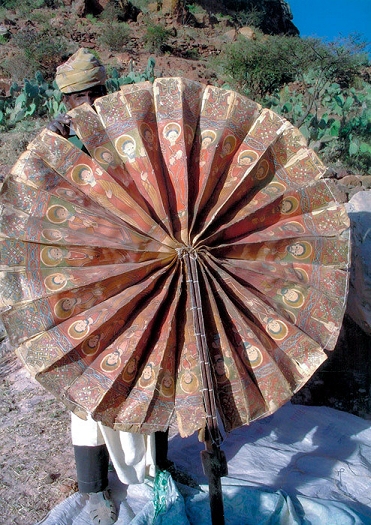
The fan at Debre Tsion
Very few exist; I think there are about six in the world, and they date to the 15th century. Apart from the two I handled the only other one I have seen is in the Walters Museum in America. Theirs, like one of the ones I was working on is incomplete, and has been conserved in a horizontal line.
Each page measures 72 x 11cm. They concertina into a pile of single pages.
The Virgin Mary is always depicted at the centre with apostles and saints on either side. For the Ethiopian church the first person to paint Mary was St. Luke, from whose image she would speak, apparently, to priests and believers. She was silent for all the time I spent with her.
The most complete fan is housed at Debre Tsion and is quite well known. I did some minor work on this. The other one was fragments, with large portions missing.
The rock hewn churches of Ethiopia are mostly in obscure places. I think the priests felt safer hidden away from potential invaders. They are difficult to get to and their contents - manuscripts, crosses, icons, etc. remain undiscovered. Jacques Mercier has spent over 30 years studying and documenting these churches and he was accompanying me to advise me on the positioning of the fragments. Our group also consisted of several people connected with the sponsorship of the project.
We flew from Addis Ababa to Mekele in the north where the holiday makers and workers parted company. Before travelling to the site of the fan we had to jump through the inevitable, time consuming, diplomatic hoops. At least Jacques did. I was just a know-nothing beside him observing how he patiently persuaded the ministry of culture representative to write the necessary letters of authorisation for working on the artefacts. Permission for photography seemed to be particularly difficult and the letters had to be re-written several times before they were of any use to us. The officials always seem very keen for the work to go ahead, but nervous of taking any responsibility. Everything moved painfully slowly.
However, finally we were on our way to Adsbi, the nearest town/village to Debre Selam, the rock-hewn church where the first fan was situated. Our approach to work each morning was in a jeep to the foot of a mountain. The church was pointed out to me - it was half way up - and after a brief moment of disbelief I started to climb.
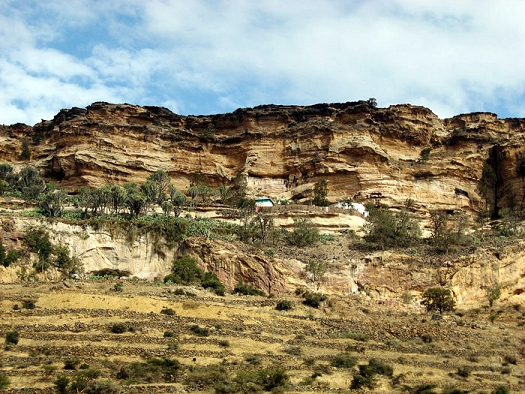
Debre Salem
Luckily local boys were always on hand to carry bags and materials etc.
The entrance was on a small terrace, with a panoramic view. Above the terrace were the remains of a previous hermit's abode - holes in the cliff, now deserted.
The first morning the head priest greeted us with the usual initial suspicion and reluctantly brought out a nineteenth century manuscript. This was a typical binding style pretty much unchanged over the centuries with large turn-ins, blind tooled. More often than not there is fabric on the inner board.
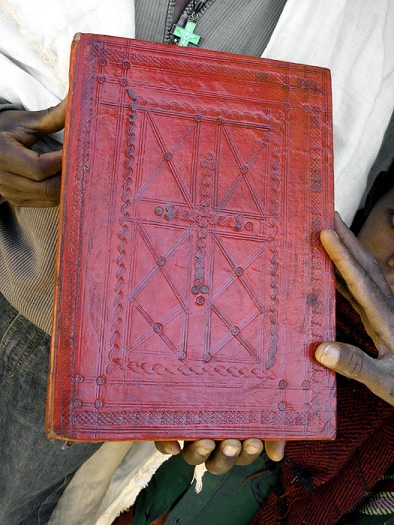
19th Century Binding
After more delays and explanations we were allowed into the church which was built into the side of the mountain. To the left, dug into the ground was a small, uninviting pool with stone steps - the priests' bath.
Immediately in front were some brightly painted pillars. The paint work was recent, possibly covering some earlier murals - this is a common occurrence. There was a more ancient inner sanctum behind a heavy curtain and through a decorated archway. I was never allowed in there although I managed to catch a few glimpses of the carvings and frescoes.
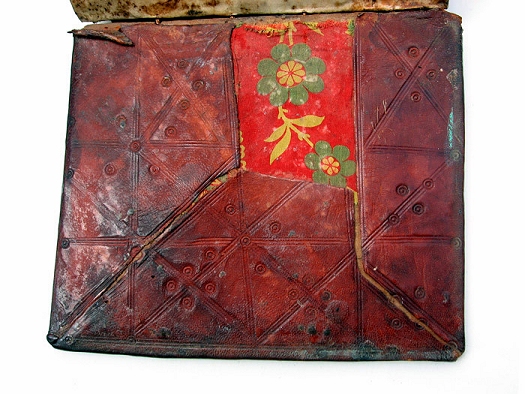
Inside Board
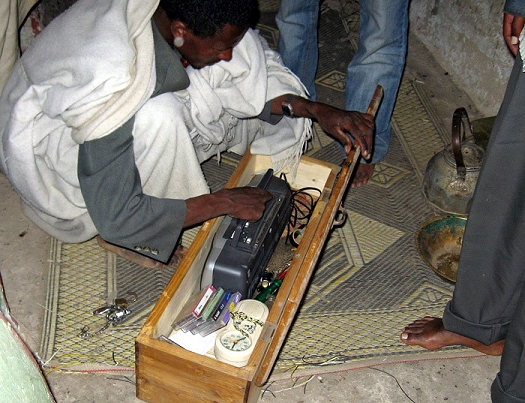
The box, the radio and the 15th Century vellum fan
Finally a wooden box was brought out - but no key. A monk was dispatched down the mountain to find the key - from where I know not. He arrived back an hour or so later and the box was opened to reveal its surprising and unlikely combination of contents. Underneath a radio, some cassettes, an alarm clock and various bits and pieces - and completely unprotected from these things, were the fragments of a 15th.century fan.
The restrictions of a rock hewn church as a place of conservation are considerable. As with my previous trip I had agreed with the sponsors that a small amount of work with minimal intervention was desirable for preventing the artifact from becoming further deteriorated. Also it would make it possible for the fan to be displayed in a showcase that was eventually to be installed, so that the few tourists that pass that way could see it and donate some much needed money to the priests.
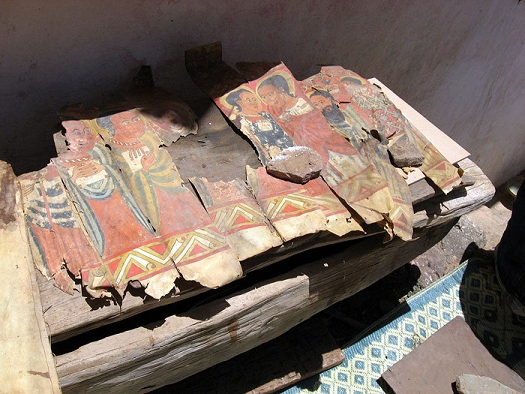
Some fragments laid out on the coffin
I was rather alarmed at the first suggestion for my workspace. This was an ancient gnarled coffin, unused: small, very uneven, rickety and exposed to the sun. Apart from that - ideal.
The pieces of vellum were laid out randomly - at this point it was very difficult for me to get near it as everyone - the priests, Jacques, our helper from Mekele, local boys were all fussing round it. Also, I was having my own private little heart attack as I thought I had discovered half my materials and tools had been left at home - they hadn't.
I explained that I could not work in this space - the only other option, though there was little light, was inside the church. The only surface was the uneven earth floor - though there was a rug (flea infested as is the custom) - upon which I set to work. Unexpectedly I located a pair of stepladders and so created an additional bench on a chunk of wood.
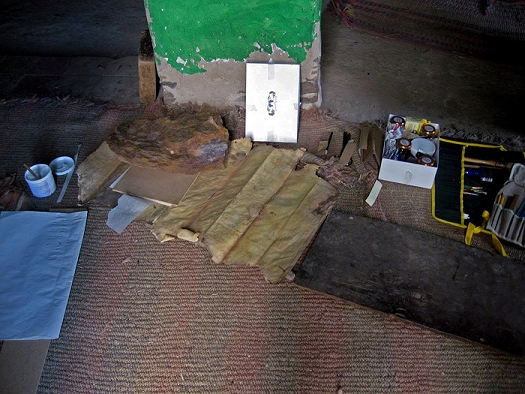
Fragments under weight on the floor
Not having seen the item before going to Ethiopia it was difficult to know precisely what would be needed. I had to basically take everything - they don't usually have anything at these churches except some cups for home made beer and a variety of fabulous ancient treasures.
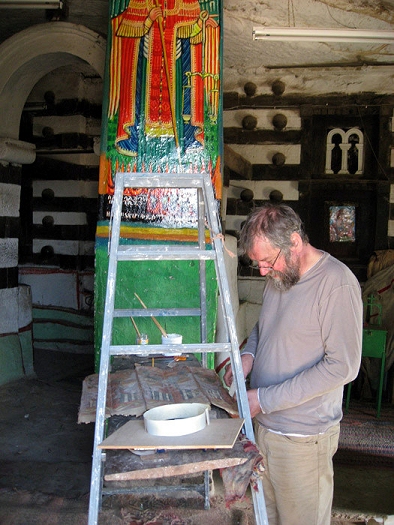
Improvised workbench - repairing reverse with Japanese papers
I took a selection of Japanese repair papers of various weights and tones - Atsukchi: Kozuke & Kozushi ; also several skins of toned vellum with as little figuring on them as possible. It was difficult to judge, not knowing the weight of the fragments.
For adhesives I had gelatin made from the vellum I was using, some wheat starch paste and neutral pva.
When I was finally able to look at the fragments on my own - although I was watched constantly by the priests - I had to assess what could feasibly be done given the restricted time and conditions. Fortunately the actual pigment on the vellum was very secure. These pieces had been rubbing together for a long time and although fragments were breaking off there was no evidence of loose pigment.
At first, I decided to do as much localised repairing of tears as I could. This I did on the reverse with the Japanese papers supporting the splits and the cracking on the vellum.
Obviously I had taken some pressing boards and silicone and blotting paper but had decided against bringing my nipping press or even weights. I got my helper and sent him to find some large rocks which served pretty well.
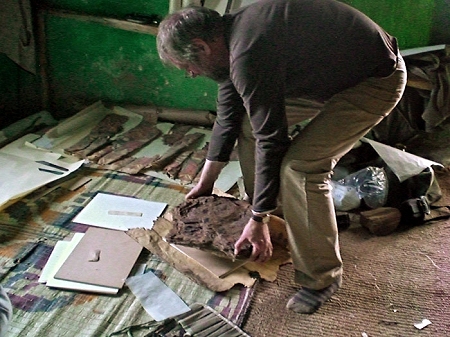
Utilising rocks as weights
With occasional coffee breaks and beer breaks work progressed well. During one of my breaks I produced lots of pairs of glasses that I had brought knowing from my previous trip that they were much sought after. They were popular with both monks and local boys. At one point I asked my interpreter what all the monks were talking about. It seems that some were jealous that they had only received the soft glasses case while others had the apparently highly prized hard snappy ones.
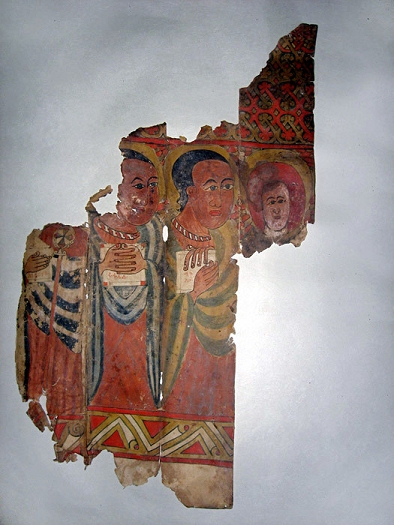
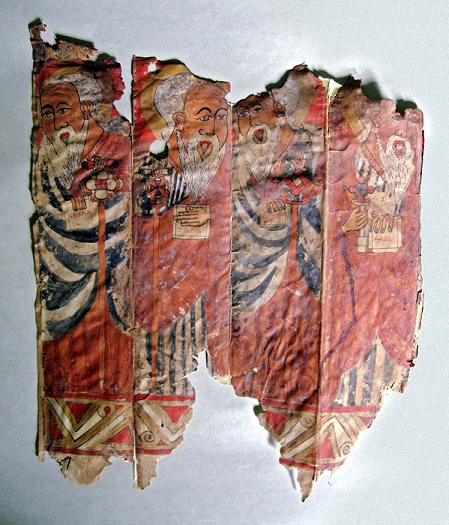
Fragments
Half way through work I asked if it was possible to have a large piece of wood to work on - I knew it would have to go on the ground but it would make things easier. This seemed to be impossible but one morning we hired from the local blacksmith a large sheet of metal. How are we going to get that up the mountain I thought - easy - a boy put it on his head and up he went.
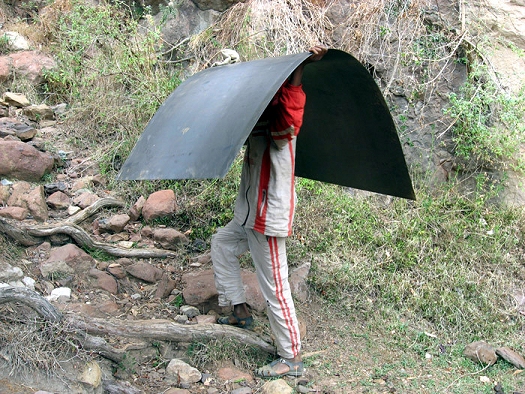
Up he went
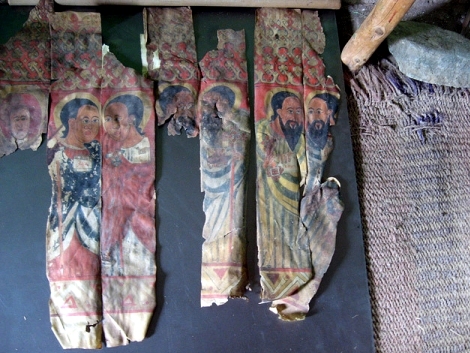
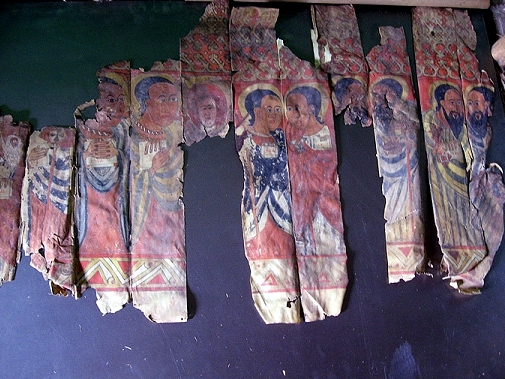
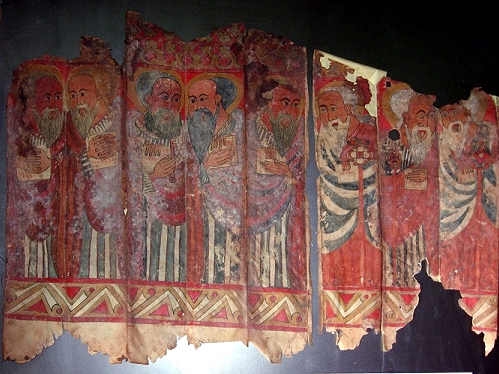
Segments on metal surface
With this I was able to lay out the partly repaired pieces with a view to joining them all together.
Having created a large patchwork of repairs from behind, I could now fill in the big missing areas with vellum. Jacques had provided me with the order in which they should go as it mostly wasn't discernable from the actual shapes of the pieces.
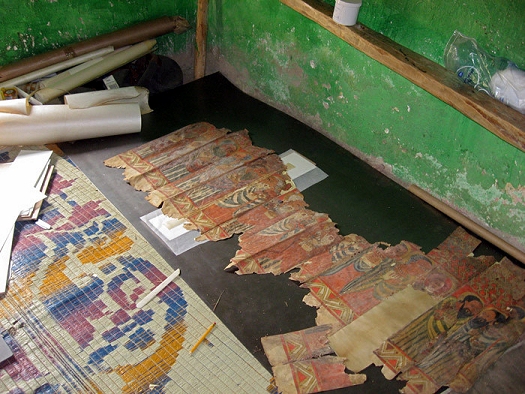
Repaired segments waiting for infill
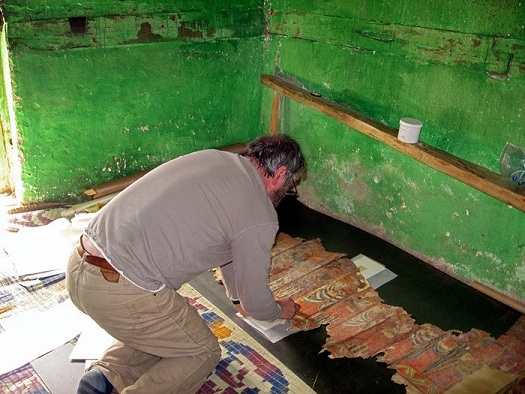
Infilling missing areas
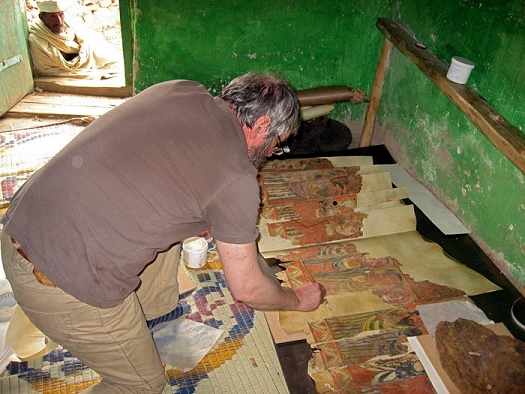
Filling in progressing, with concertina folds
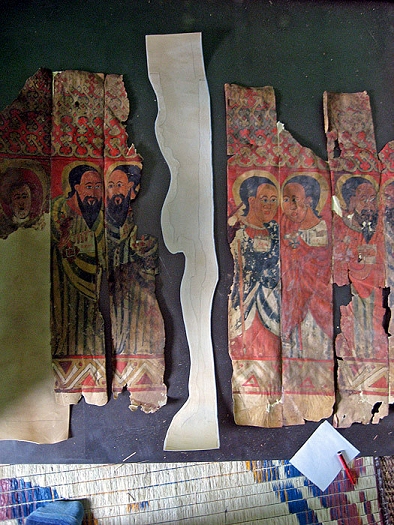
Profiles Infill
So, the filling in was done with the toned vellum. I had not known how much would be needed but thankfully, and incredibly, I had brought just enough. I profiled the missing shapes, thinned down the edges of the new vellum and scraped slightly for better adhesion where it overlapped. Fortunately there were no images on the reverse of the segments so I could afford a good overlap at the joins. I applied the vellum with my home made gelatin supplemented if necessary with a reversible pva paste mix. The joins were then 'pressed' by leaving them between silicone paper, blotting paper and pressing boards, under a heavy rock.
The pages were folded along the original folds and concertinaed to fit between 2 pieces of wood, bound round with hemp. Some small areas remained that could not be repaired as Time, the great enemy was pressing in - I had to finish here and drive hundreds of miles through the Geralta landscape to Debre Tsion to work on the other fan.
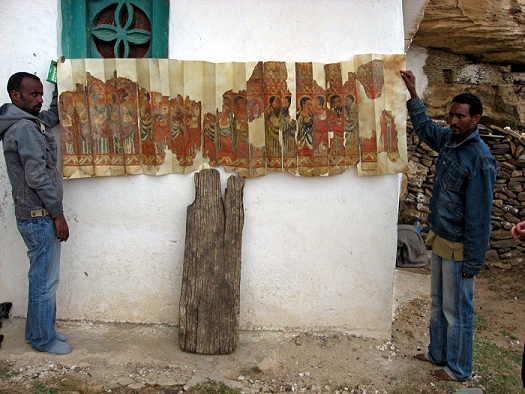
Completed repairs
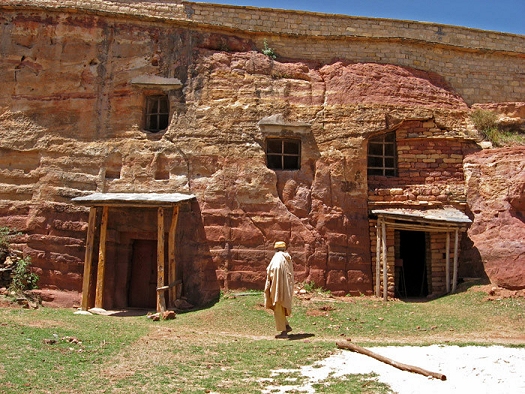
Debre Tsion
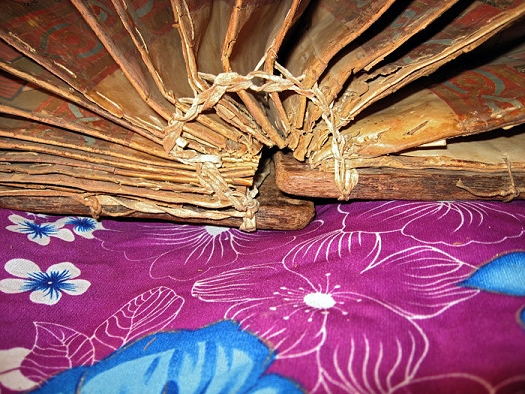
Thread mechanism
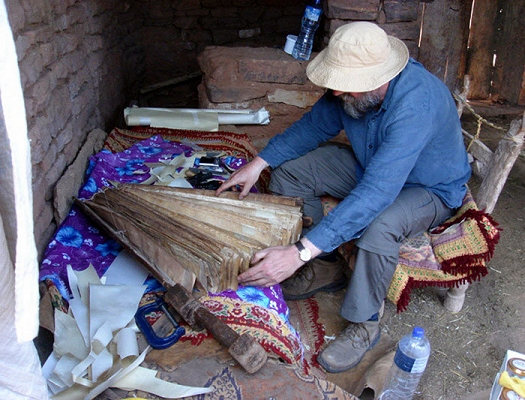
Repairing the fan in the farmyard bindery
This fan is generally known of and is mentioned in guidebooks. It is in a much better condition. We visited the church where it is kept - a steep climb.
Thankfully the fan had been brought down to a farm where one of the monks lived and worked with his family.
I set up my workshop in a small space across the yard from the animals sleeping quarters, which was next to the family's kitchen where they all spent virtually all day occasionally venturing out to bring me coffee and nuts.
My time here was very limited, and with the condition of the fan being quite reasonable I decided on only some minor vellum repairs across splits in the folds
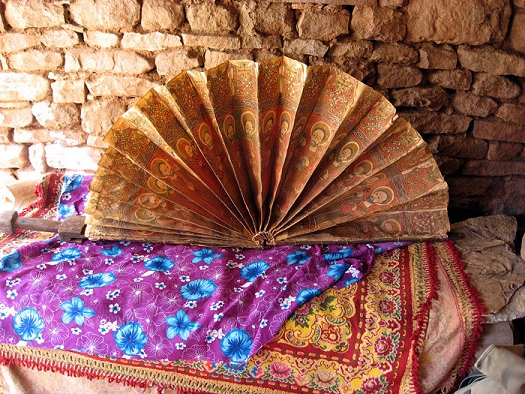
Half opened fan
I certainly didn't want to take it apart, and did not have time to figure out how to put it together again. If it could go to a conservation workshop more of course could be done. But that will never happen - they do not allow these artefacts out of their sight; and they have managed to hold on to them for centuries. There are now, and have always been robbers, illegal dealers, illicit traffickers of antiquities ready to target these churches. It is good that more work is now being done by the government, with help from people like Jacques to preserve, protect, research and document the objects.
Visitors will consider them as wonderful works of art but of course they have special religious significance and spiritual symbolism for the church. The priests and believers deeply respect and venerate the holy treasures and love and protect them accordingly.
 Lester Capon trained at Camberwell School of Art and Crafts from 1975 - 1977. He trained with and worked for James Brockman from 1977 - 1993. This involved working on a wide range of books, repairing manuscripts and early printed books and fine binding and presentation boxes. From 1993 - 2000 he was Programme Manager for the Fine Binding and Conservation course at Guildford College. Since 2000 he has worked as a self- employed bookbinder in Tewkesbury.
Lester Capon trained at Camberwell School of Art and Crafts from 1975 - 1977. He trained with and worked for James Brockman from 1977 - 1993. This involved working on a wide range of books, repairing manuscripts and early printed books and fine binding and presentation boxes. From 1993 - 2000 he was Programme Manager for the Fine Binding and Conservation course at Guildford College. Since 2000 he has worked as a self- employed bookbinder in Tewkesbury.
He was elected a Fellow of Designer Bookbinders in1986 and was President from 2003 - 2005. Collections include - British Library, HRHRC Texas, John Rylands University Library Manchester, Liverpool Library, private collections in U.K. and abroad.
